- News
- Reviews
- Bikes
- Accessories
- Accessories - misc
- Computer mounts
- Bags
- Bar ends
- Bike bags & cases
- Bottle cages
- Bottles
- Cameras
- Car racks
- Child seats
- Computers
- Glasses
- GPS units
- Helmets
- Lights - front
- Lights - rear
- Lights - sets
- Locks
- Mirrors
- Mudguards
- Racks
- Pumps & CO2 inflators
- Puncture kits
- Reflectives
- Smart watches
- Stands and racks
- Trailers
- Clothing
- Components
- Bar tape & grips
- Bottom brackets
- Brake & gear cables
- Brake & STI levers
- Brake pads & spares
- Brakes
- Cassettes & freewheels
- Chains
- Chainsets & chainrings
- Derailleurs - front
- Derailleurs - rear
- Forks
- Gear levers & shifters
- Groupsets
- Handlebars & extensions
- Headsets
- Hubs
- Inner tubes
- Pedals
- Quick releases & skewers
- Saddles
- Seatposts
- Stems
- Wheels
- Tyres
- Health, fitness and nutrition
- Tools and workshop
- Miscellaneous
- Cross country mountain bikes
- Tubeless valves
- Buyers Guides
- Features
- Forum
- Recommends
- Podcast
review
£1,165.00
VERDICT:
Intuitive and easy-to-use electronic gear system with an excellent choice of gears for on and off-road riding
Very easy to set up
Crisp gear shifts
Plenty of options to integrate with other Force setups
Not cheap
Derailleurs look bulky because of the batteries
Weight:
1,522g
Contact:
At road.cc every product is thoroughly tested for as long as it takes to get a proper insight into how well it works. Our reviewers are experienced cyclists that we trust to be objective. While we strive to ensure that opinions expressed are backed up by facts, reviews are by their nature an informed opinion, not a definitive verdict. We don't intentionally try to break anything (except locks) but we do try to look for weak points in any design. The overall score is not just an average of the other scores: it reflects both a product's function and value – with value determined by how a product compares with items of similar spec, quality, and price.
What the road.cc scores meanGood scores are more common than bad, because fortunately good products are more common than bad.
- Exceptional
- Excellent
- Very Good
- Good
- Quite good
- Average
- Not so good
- Poor
- Bad
- Appalling
Rather than develop a specific groupset for gravel/adventure use, SRAM has created an offshoot of its second-tier drivetrain, known as Force eTap AXS Wide. It carries over the excellent shifting quality and easy use of the standard Force setup but with a wider gear range and a physically wider Q-factor which gives frame designers more scope to increase tyre clearances.
Who’s it for?
Gravel and adventure riding has continued to gain popularity over the last few years and we've already seen Shimano launch a specific groupset range, GRX, to bring more suitable gear ranges to suit the conditions.
> Find your nearest dealer here
SRAM already has its 1x drivetrains, but this Force eTap AXS fills in a lot of gaps, and not just for riding off road – there are many of us who would like lower gear ranges from a 2x system with small jumps between sprockets for loaded touring or just spending time climbing in the mountains.
It's not just the gear ratios that have been thought about, though, but also the width between the cranks, the Q-factor, as I mentioned above.
We have seen frames like the Open UP come with a dropped chainstay on the drive side to provide tyre and chainset clearance while keeping the chainstays as short as possible.
By increasing the chainline to 47.5mm, the SRAM Wide chainset allows more clearance than a standard road setup, enabling an increase in tyre size while still using a 2x system. Many gravel bikes with big tyre clearance are restricted to 1x systems because of the tyres fouling the front mech. The Force Wide mech used here sits outboard by an extra 2.5mm to match the chainset, which SRAM says increases clearance to 45mm for a 700C tyre, and 2.1in for a 27.5in tyre.
How low can you go?
Over the course of the month that I've been testing the Wide drivetrain I also had two bikes wearing the standard Force eTap AXS, brand new models from Vitus (its Vitesse Evo Team) and the Canyon Endurace CF SLX Disc 8.0 eTap.
One thing I have noticed while riding these two bikes around is that these 12-speed systems from SRAM already use really sensible ratios compared to what we are used to. For instance, the Vitus has a 48/35-tooth chainset paired to a 10-33t cassette, which offers a wider range of gearing than most drivetrains at both ends of the spectrum while still maintaining small jumps on the cassette.
> How to get ultra-low gearing for your gravel bike adventures
The Force eTap Wide has a 43/30t chainset and a 10-36t cassette, which gives you some very low gears while still enabling you to maintain a high top speed on faster sections without going too mad on the cadence front.
To put that into context, on a 700C wheel with a 38mm-wide tyre you'd have a top gear of 118in and a lowest gear of just under 23in.
The Specialized Diverge I recently reviewed came with a 48/32t chainset and an 11-34t cassette, giving a maximum gear of 119in and a low of 25.8in.
Fettling
The Canyon became the donor bike as it already had the Force eTap AXS electronic shifters, bottom bracket and braking system in place. While not a gravel bike exactly, it does come with 30mm tyres as standard and has room for 32mm tyres with a bit of tread on them, which makes it capable enough on the local byways and hardpacked gravel tracks.
I've never had to set up an electronic groupset before but the whole process was unbelievably easy thanks to a few YouTube tutorials from SRAM and competent bike fettlers.
Firstly, if you aren't aware, eTap systems are completely wireless – the gear levers send signals to the derailleurs and they do what you ask.
Each shifter only has one button for changing gear, which sits where you'd find the paddle on its mechanical shifters. The button on the right shifter drops the chain down the cassette while the button on the left makes it climb back up. To change between chainrings you press both buttons together.
Power is taken care of by a coin battery in each shifter, while both the front and rear mechs get their own rechargeable battery pack. So with no wires it is literally plug and play.
Before installing them onto the bike you just need to press the AXS buttons on the components to get them to talk to each other – and then have a bit of fun scaring the kids by hiding and making the mechs change gear and jump around on the worktop...
The chainset was the first thing to be swapped out. The Force crankset is designed to work with SRAM's DUB bottom brackets, and unlike a lot of chainsets which have the spindle attached to the drive side crank, the Force has it attached to the non-drive.
You feed it through the frame and locate the splines on the end of the spindle with those on the drive side, and tighten it up with an 8mm hex key.
Because of the 5mm extra spindle length you won't be able to use a standard width bottom bracket, you will need one that has the 'WIDE' suffix in the name as it will come with the extra spacers needed. SRAM had included spacers in our kit.
The mechs bolt to the frame just like any others and SRAM has put some really helpful marks and guides on the front mech for height and chain alignment.
On both the front and rear, the high and low limits are set by using a screwdriver on the designated screw. I know! How old school!
After that it was just a little bit of fettling using the buttons on the shifter to micro-shift the mechs left or right to fine-tune the shifting and get rid of any chain rub.
You might notice in the pictures the Flattop chain. This design gives better clearance for the chain to skip across the 12 sprockets which sit closer together, fitting in the space where there would normally be 11.
One thing to note is that the cassette is XDR compatible only, so you might need to upgrade your wheelset or at least the freehub.
On the road... and off
I wasn't really expecting any less to be honest, but the gear shifts across the Wide drivetrain are just as crisp and precise as they are on the standard version.
The 13-tooth gap between the two chainrings caused no issues when changing under load on a steep hill, and the front mech delivers the gear change quickly and smoothly.
The only time I dropped the chain was when I was really pushing it to see how it would react trying to change from the big to the small ring when under a stupid amount of load with a really low cadence. There was no mechanical sympathy at all, no easing off; I'd never shift rings like that when riding normally.
Increasing the chainline at the crankset hasn't caused any issues with the rear shifting, with the chain jumping up and down the cassette quickly and smoothly.
The lower sprockets of the cassette only have small jumps between them so I wasn't expecting any issues here, but even as those gaps increase the rear mech just deals with it, even the four-tooth gaps as the sprockets jump from 24t to 28t to 32t and then the 36t.
The ratios on offer make the Force Wide drivetrain feel very efficient. Over the course of a year I probably split my riding about 60/40 in favour of road over gravel but even when I'm out on the gravel I do prefer a 2x groupset over a 1x purely because I'm not a fan of the gaps between sprockets and the gear limitations at either end.
This setup works well whatever the terrain. I never felt as though I was in the wrong gear or trying to tweak my cadence to suit.
The shifting is so good that it is no problem to keep changing gears; even when coated in dust or mud the Force Wide just gets on with the job.
SRAM's Orbit damper – a silicone fluid damper that it says "limits chain bounce by controlling the chain's downward movement when riding over bumps" – also kept the chain taut and stopped any slap on really rough roads or tracks. I fitted some 32mm slightly knobbled tyres to the Canyon to test it out on the latter.
The new chain also ran quietly and smoothly whatever ratio I was using, and was surprisingly unnoticeable even when using the extremes of the gearing thanks to the constant tweaks that the front mech makes to itself.
Versatility
If you wanted to run these gear ratios on a bike already equipped with Force eTap AXS you are going to have to replace the chainset, front mech, rear mech and cassette, and sort the spacers for the bottom bracket, so it is quite an outlay price-wise.
If you were on a 1x system but wanted the lower gears of this 10-36t cassette you would just need to replace the cassette and rear mech. The mech is compatible with some of the others in the range, including the 10-33t and 10-28t (but not the 10-26t), so you can chop and change.
This is also true if you want to stick with your standard chainset and front mech but want the lower gears from the 10-36t cassette.
AXS
The AXS part of the name means it has compatibility with SRAM's app, which lets you customise the shifting of the drivetrain and allows two automated modes: sequential (similar to Shimano's Synchro Shift) and compensating (similar to Shimano's semi-Synchro Shift).
Sequential takes care of front shifts, which makes riding easy as you don't need to worry about what chainring you're in, and the compensating mode moves the rear mech to maintain your cadence after a front shift.
I've been using the latter most often on the standard sized Force groupsets and it is pretty intuitive, although I'm perfectly happy just pushing the buttons myself.
The app also lets you see battery life in the three motorised components, and you can set up more than one bike at a time in your account.
You can also tweak which buttons change which gears too.
Value
As I said earlier, there are few specific gravel/adventure groupsets on the market other than Shimano's GRX.
Money-wise, looking at just the specific components that make up the Force Wide group, the prices are much higher than the GRX Di2 equivalents.
The chainset is £390 and weighs 705g; the cassette is £170 and 301g; the rear derailleur is £415 and weighs 306g (plus 25g for the battery); and the front derailleur is £290 and weighs 160g (plus 25g for the battery).
The top-end GRX chainset, for instance, is just £199.99, nearly half the price of the SRAM. True, the latter does have carbon fibre cranks, which certainly deliver on the stiffness front, but you are literally only saving 5g in weight.
The other components compete well on weight, too, so it just comes down to price. Adding the totals of the components together, the SRAM comes in at £1,165 whereas the GRX Di2 is £775. That is at rrp, mind, and things can be very different out in the marketplace.
It isn't a true comparison, though, as SRAM and Shimano have taken very different routes. Shimano has stuck with 11-speed while SRAM has gone 12, plus it has completely wireless shifting whereas Shimano's is cabled.
It'll be interesting to see how the market pans out when and if other gravel/adventure drivetrains become available from other brands.
Conclusion
The SRAM Force eTap AXS Wide groupset works brilliantly – the shifting is great, and it provides such usable gear ratios for the type of riding it is designed for, whether that's on or off-road. Yes, it's a big financial investment, but with it being so simple to use, I'd say it's up there with the best drivetrains on the market.
Verdict
Intuitive and easy-to-use electronic gear system with an excellent choice of gears for on and off-road riding
road.cc test report
Make and model: SRAM Force eTap AXS Wide groupset
Size tested: 43/30 chainset, 10-36 cassette, 172.5mm cranks
Tell us what the product is for and who it's aimed at. What do the manufacturers say about it? How does that compare to your own feelings about it?
SRAM says, "Road riders are going beyond where we've ever gone before. We're going further and faster. And when the road stops, we keep going. One thing hasn't changed: We want to push those boundaries without any distractions. Exploring new limits has never been easier."
This is a very good drivetrain option for those who want lower gears for road and gravel use while maintaining gears at the top end.
Tell us some more about the technical aspects of the product?
Cassette: 12spd, 10-36t, XDR compatible
Rear Derailleur: 12spd, compatible with 10-36t, 10-33t, 10-28t & 10-26t cassettes, uses existing eTap batteries.
Front Derailleur: Works with Wide 43/30t chainset only, SRAM Yaw trimless cage technology with optimised cage profile for new chainring combinations
Chainset: 43/30t rings, 47.5mm chainline, 165mm to 177.5mm cranks lengths in 2.5mm increments
Rate the product for quality of construction:
9/10
Rate the product for performance:
9/10
Rate the product for durability:
8/10
Rate the product for weight (if applicable)
7/10
Rate the product for value:
6/10
It's quite a bit more expensive than the Shimano GRX equivalent but does bring an extra sprocket to the mix, looks more bling and the technology works really well.
Tell us how the product performed overall when used for its designed purpose
Precise shifting across the entire range and it runs smoothly too.
Tell us what you particularly liked about the product
A really wide and usable range of gear ratios.
Tell us what you particularly disliked about the product
It is a large investment.
How does the price compare to that of similar products in the market, including ones recently tested on road.cc?
There aren't a huge amount of drivetrain options like the Force eTap AXS Wide groupset on the market, with the closest rival being Shimano's GRX Di2 when it comes to electronic shifting with lower gear options. The SRAM option is quite a bit more expensive but does bring an extra sprocket to the mix, it looks more bling and the technology works really well indeed.
Did you enjoy using the product? Yes
Would you consider buying the product? Yes
Would you recommend the product to a friend? Yes
Use this box to explain your overall score
I was properly impressed with the Force eTap setup. It is so easy to use and SRAM has totally nailed the ratios and the quality of shifting across this wide-ranging groupset. Yes, overall it is quite an investment, but one I'd happily make.
About the tester
Age: 41
I usually ride: This month's test bike My best bike is: B'Twin Ultra CF draped in the latest bling test components
I've been riding for: Over 20 years I ride: Every day I would class myself as: Expert
I regularly do the following types of riding: time trialling, commuting, club rides, sportives, fixed/singlespeed,
Since writing his first bike review for road.cc back in early 2009 senior product reviewer Stu has tested more than a thousand pieces of kit, and hundreds of bikes.
With an HND in mechanical engineering and previous roles as a CNC programmer/machinist, draughtsman and development engineer (working in new product design) Stu understands what it takes to bring a product to market. A mix of that knowledge combined with his love of road and gravel cycling puts him in the ideal position to put the latest kit through its paces.
He first made the switch to road cycling in 1999, primarily for fitness, but it didn’t take long for his competitive side to take over which led to around ten years as a time triallist and some pretty decent results. These days though riding is more about escapism, keeping the weight off and just enjoying the fact that he gets to ride the latest technology as part of his day job.
Latest Comments
- stonojnr 1 hour 14 min ago
From what I understood from lawyers, there's nothing preventing a charge of manslaughter being applied in addition to death by dangerous driving...
- AidanR 1 hour 30 min ago
"Jonas was talking about how he was dizzy. I didn’t have the impression that he was very lucid."...
- Dnnnnnn 2 hours 1 min ago
Nocturnal implementation isn't ideal but I think your final sentence captures why it was probably necessary....
- Mr Anderson 2 hours 26 min ago
In 1981 I bought a bike from Halfords that cost £115. Today, that is the equivalent of £670. Yet a bike of that value today is considerably...
- dh700 2 hours 34 min ago
Okay, so what precisely are you unable to understand, or are claiming is incorrect? Rather than hiding behind a poorly-written Biblical verse, why...
- wtjs 2 hours 45 min ago
when the killer's colleagues showed up, he claimed the cyclist "Came out of nowhere". And, until the local news station investigated and found the...
- IanGlasgow 2 hours 51 min ago
You have to not just obey the legal requirements of The Highway Code (riding on the road not the pavement, have lights and reflectors, etc.), but...
- Pedal those squares 4 hours 49 min ago
I thought if things got that bad the rear cassette could crack open a bottle!
- mdavidford 5 hours 41 min ago
Most of those people aren't cycling as sport, though, which is the relevant outcome for BC's purposes....
- Jamie Williams 6 hours 4 min ago
Not sure how that snuck in! Now changed :)























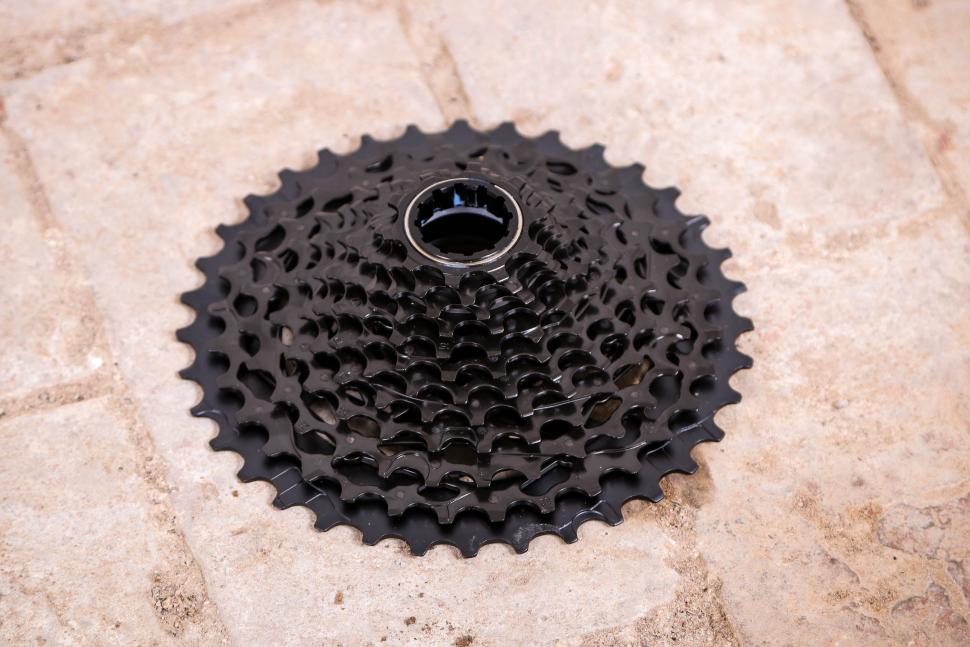

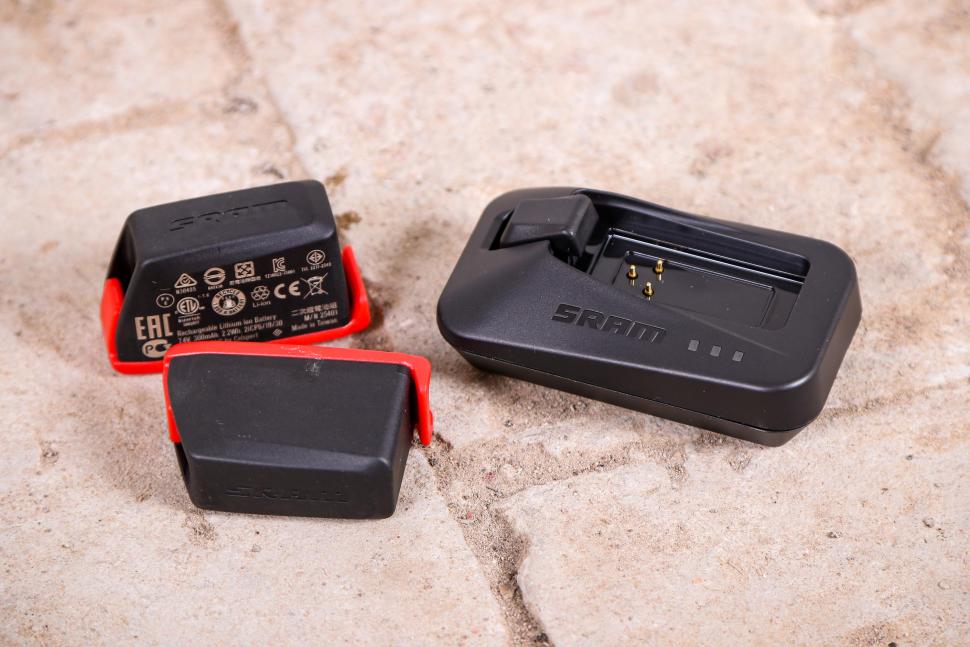


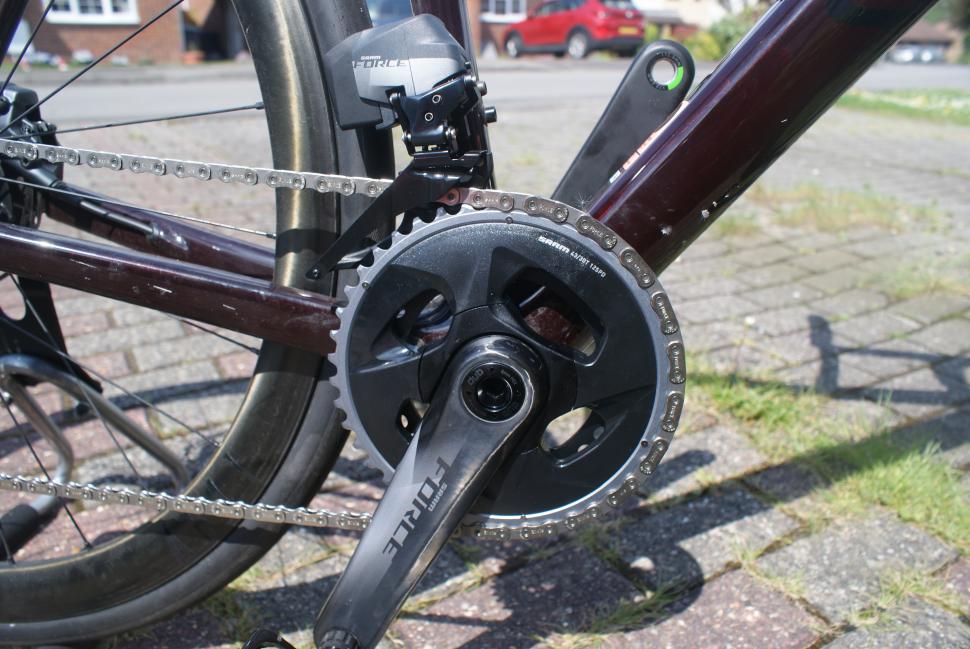





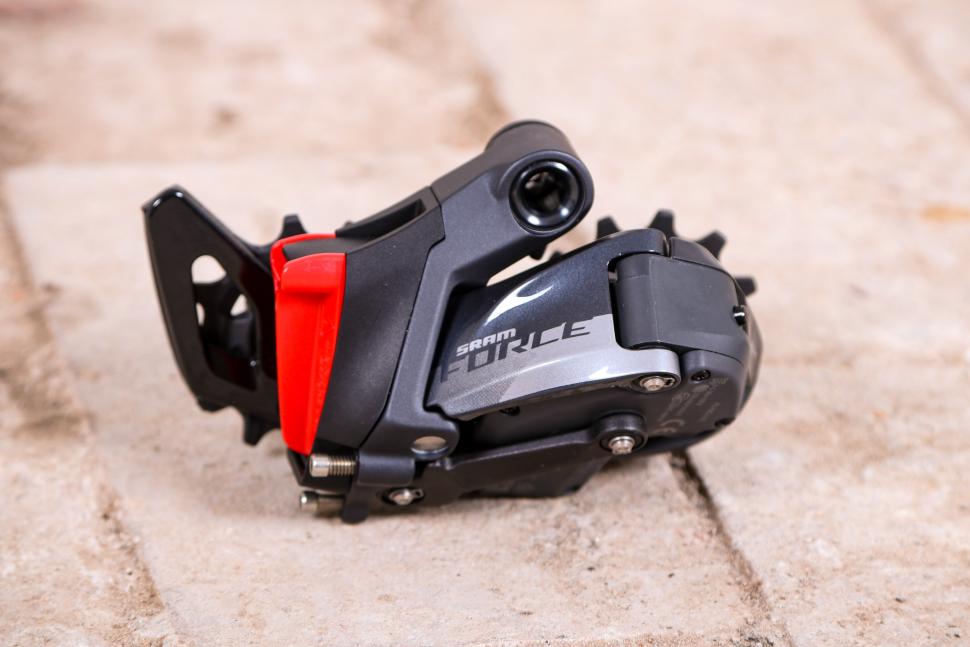


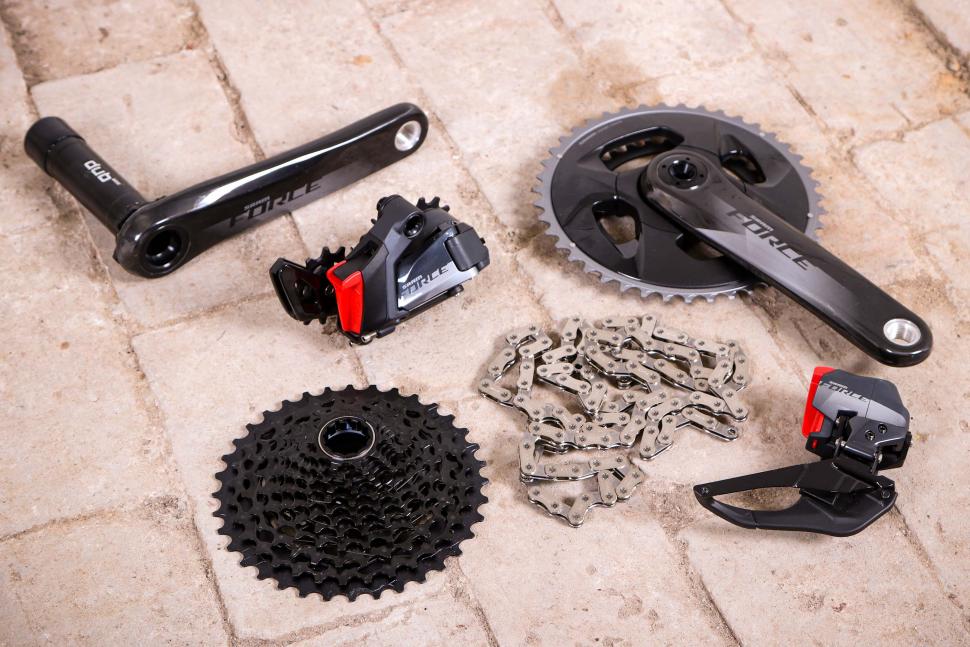



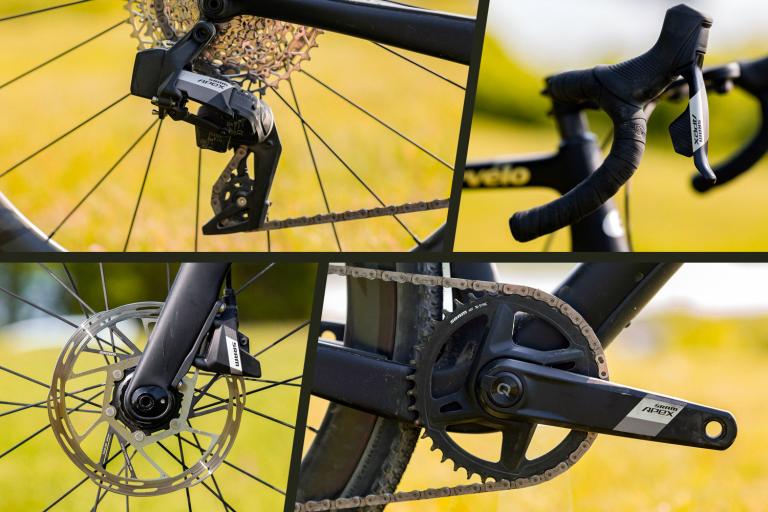
Add new comment
15 comments
Hi road.cc, do you realise how bad your site is on Safari browser - ads are one thing but it gets a bit silly when you cannot even read the article - please fix it.
Works ok using DuckDuckGo
Just as bad on Chrome for iPad. Drives me crazy trying to read articles.
Raspberry Pi + Pi Hole. I find the Web largely unusable without this, with sites full of ads (and often inaccessible if using a software based ad blocker).
I'd love to be a fly on the SRAM marketing teams wall when they discuss pricing. Etap is a neater solution than Di2 and bypasses all that nastly cabling, but they have priced Force at a premium well above Ultegra Di2 (and GRX DI2).
They obviously think the wireless and 12 speed aspects deserve that premium but I have to wonder if they couldnt grab a much larger chunk of the market if they tried a bit harder on price. I guess the the original big S is still the 800lb gorilla in the market so you annoy them at your peril, but it would be nice to see etap come down 3-400 squids and compete directly with Ultegra/GRX Di2 which is showing its age from a technology perspective.
Wiggle have Dura ace Di2 for 2k at the moment, Could not agree more Sram would totaly nail it if force were at or nearer to ultegra di2 price point. Force AXS it just 3-400 pounds to much at the moment.
No 10-42
This looks cool and more like axs should have been in the first place. Bit disappointing that they didn't extend it's capability up to a 40t or 42t cassette (I know Eagle exists, but the middle ground between axs and Eagle is around 40t) - I run an eTap wifli rear mech on a 36t with no problems at all. One thing I don't buy is that 2.5mm further outboard on the chainline is going to make any meaningful difference to clearance in the real world (i.e. if it's a case of running 700c WTB 42s vs. 45s, that's an easier solve than a random crankset and if you're running 45+ in a gravel setup, there's a good chance they're on 650bs). All of this leads me full circle to think that this is just the axs equivalent of the old wifli eTap rear mech, with the added benefit of the clutch mechanism - the rest seems unneccessary proprietary 'stuff' that doesn't have much utility or need (not that component manufacturers are ever guilty of that).
If I read this right (& I may not have!) does it mean you can run the standard road (46/33, 48/35 or 50/37) front rings with the 10/36 cassette only having to fit the new rear mech?
I think you need to add the "WiFli" system for big ring differences, and that's extra ( as always ).
How certain are those prices? £1100 whilst fairly eye watering seems to be substantially cheaper than the existing Force Axs 2x12 kit which seems to be around £1500?
Is this now the cheapest way to get eTap/Axs?
The prices have been provided directly from Sram.
Bear in mind, the overall price here is just for the 'Wide' components which includes the two mechs, chainset and cassette.
Ahh. Add on the shifters and the brakes and it'll be roughly the same then if not a little more.
It's rather misleading to quote the price of the "groupset" at £1100 when that's just the price of the upgrade to the wide gear range.
Thanks for the review. Looks good, but a shame about the four-tooth gaps for the lowest four ratios. More difficult to maintain a regular cadence on steeper climbs.